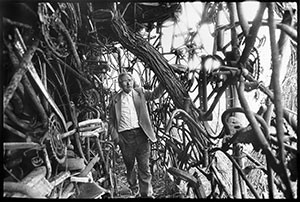Born 1916, Valley Head, Alabama
Died 2001, Rome, Georgia
Howard Finster began preaching at age sixteen. To support his evangelical work, which often involved traveling to give tent revival sermons, he took on an assortment of handyman jobs. Once while repairing a bicycle, he claimed to have seen a face on a smudge of white paint, inspiring him to try painting a portrait of George Washington from a dollar bill. The sixty-year-old Finster then spent the next twenty-four years creating thousands of artworks, which he displayed in the roadside installation he began building in Pennville, Georgia, in the early 1960s and later called Paradise Garden. By the end of the 1970s, he had become one of the most famous folk artists in the US, attracting tourists and coverage in major media outlets.
Finster approached art as the most memorable, effective way to spread his evangelical message. His sermonlike paintings mix fantastic, otherworldly vistas with hand-lettered biblical verses, fire and brimstone admonishments, and personal aphorisms, often riddled with creative misspellings and wordplay. He also depicted popular subjects and patriotic historical figures. He translated his visions at a rapid pace, comparing himself to a television. This prolific output, mass-produced with the help of his family, was installed among the assemblages and whimsical structures of Paradise Garden, where they were offered for sale. A consummate showman, Finster embraced the media as a way to amplify his message, notably collaborating on album art and music videos with R.E.M. and the Talking Heads. In taking advantage of his celebrity to promote his message ceaselessly, Finster modeled himself after Elvis Presley, who became one of his favored subjects.
Vision of a Great Gulf on Planet Hell embodies Finster’s idiosyncratic apocalyptic imagery, portraying an infernal landscape overlain with descriptive labels, admonitions, and scriptural fragments. The more bucolic scene of Take My Yoke Upon You and Learn of Me Saith Jesus, #1,060 is also interwoven with fragments of a didactic sermon. Finster’s admiration for secular figures such as Henry Ford is the fulcrum of another piece, which depicts a gallery of historical portraits made of worked aluminum within a signature handmade frame.
Jenevive Nykolak
Davies, Glen c., Stranger in Paradise: The Works of Reverend Howard Finster. With Jim Arient, Phyllis Kind, and Norman J. Girardot. Champaign, IL : Krannert Art Museum and Kinkead Pavilion, 2010. Girardot, Norman J. Envisioning Howard Finster: The Religion and Art of a Stranger from Another World. Berkeley: University of California Press, 2015.
